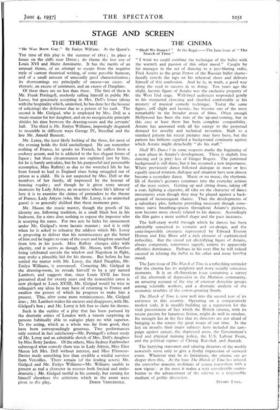THE CINEMA
" Shall We Dance?" At the Regal.—The June issue of "The March of Time " " I WISH we could combine the technique of the ballet with the warmth and passion of this other mood." Caught by his manager in the act of dancing to a jazz-blaring radio, Fred Astaire as the great Petrov of the Russian ballet shame- facedly reveals the taps on his rehearsal shoes and delivers himself of this confession. And he is, in truth, a good way along the road to success in so doing. Ten years ago the slight, laconic figure of Astaire was the exclusive property of the West End stage. Well-bred audiences responded gently to his mannered clowning and chortled comfortably at his mastery of musical comedy technique. Today the same figure, still slight and laconic, has become one of the most remarkable in the broader arena of films. Often enough Hollywood has been the ruin of the up-and-coming, but in this case at least there has been complete compatibility. Astaire has answered with all his energy to the perpetual demand for novelty and technical invention. Built to a standard pattern his recent pictures may have been, but the pattern has hitherto supplied a background continuity against which Astaire might detachedly " do his stuff."
Shall We Dance ? in some respects marks the beginning of a new phase in Astaire's development. There is slightly less dancing and (a pity) less of Ginger Rogers. The patterned background is still there, but it has assumed a new importance. Where previously dance followed dialogue in more or less equally spaced rotation, dialogue and situation have now almost become a secondary dance. Music or no music, the rhythmic lilt of Astaire's gestures continues into the everyday actions of the story scenes. Getting up and sitting down, taking off a coat, lighting a cigarette, all take on the character of dance movements even though they may be played against a back- ground of inconsequent chatter. Thus the developments of a subsidiary plot, hitherto providing necessary though some- times naïve breathing-spaces throughout Astaire's pictures, now become more closely related to his dances. Accordingly the film gains a more unified shape and the pace increases.
The half-crazy world through which he dances has been admirably conceived in scenario and set-design, and the semi-impossible creatures represented by Edward Everett Horton and Eric Blore add a rich clement of sophisticated imbecility. But the casual yet electrifying figure of Astaire, always competent, sometimes superb, retains its apparently effortless dominance. Perhaps in his next film he will indeed succeed in relating the ballet to his other and more familiar mood.
The June issue of The March of Time is a refreshing reminder that the cinema has its weightier and more socially conscious moments. It is an all-American issue containing a survey of the aftermath of depression in the Mormon community, an amusing account of the rise of amateur detective groups among scientific workers, and a dramatic analysis of the economic troubles of the cotton-growing-South.
The March of Time is now well into the second year of its existence in this country. Operating on a comparatively modest scale, it is steadily building up a reputation for the vital presentation of fact which the British cinema, with its recent passion for luxurious fiction, might do well to emulate. Its strength lies in the fact that its directors are not afraid of bringing to the screen the great issues of our time. In the last six months their major subjects have included the cam- paign against cancer, the depressed areas, the Government's food and physical training policy, the U.S. Labour Front, and the political regimes of Chiang Kai-shek and Ataturk.
The hurrying statesmen and saluting dictators of the weekly newsreels serve only to give a frothy impression of outward event. Whatever may be its limitations, the cinema can go deeper than this. At the least The March of Time has infused the somewhat anaemic traditions of screen journalism with a new vigour : at the most it makes a very considerable contri- bution to the advancement of the cinema as a responsible medium of public discussion.
STUART LEGG.










































 Previous page
Previous page